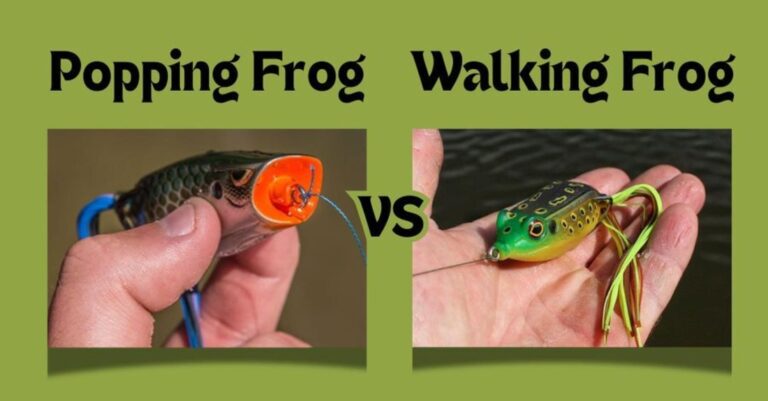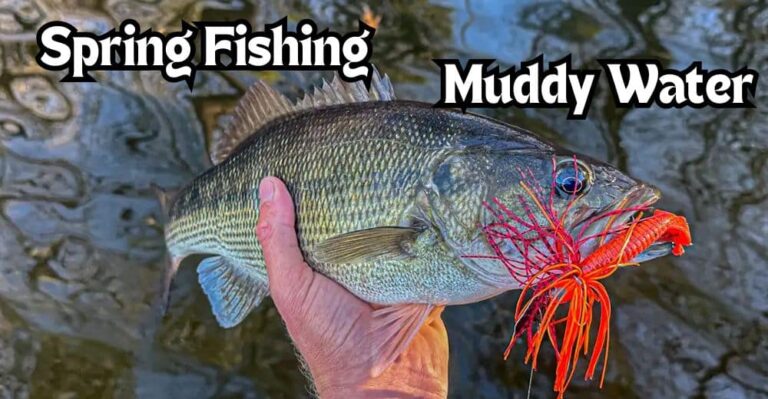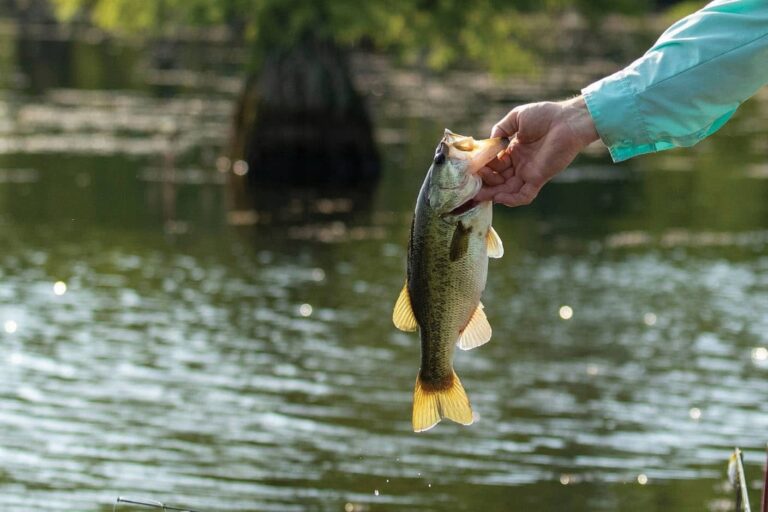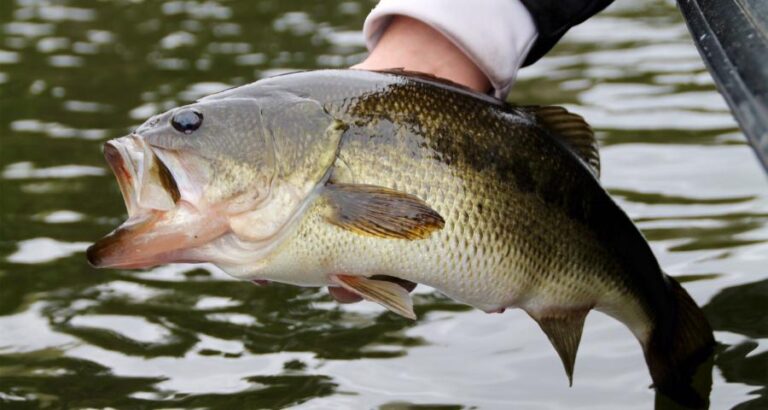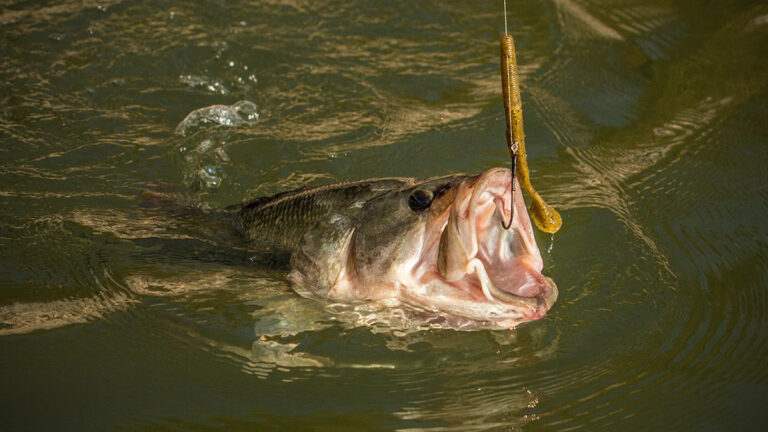Bass Fishing Rigs Beginners: Simple Rigs to Use When Getting Started
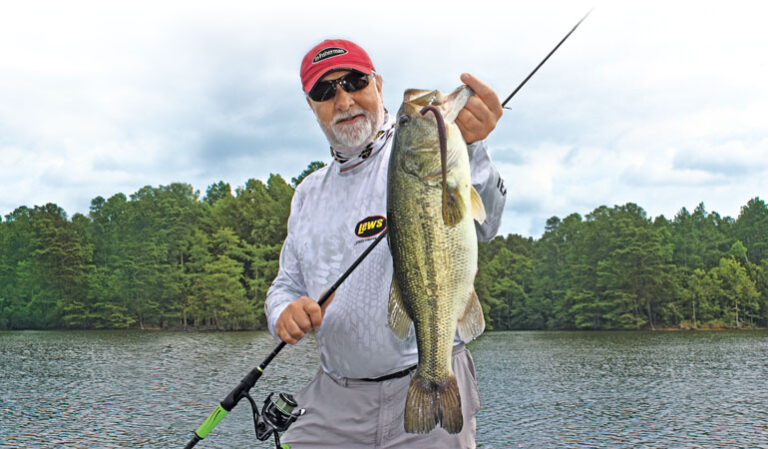
Hey there, fellow fishing enthusiasts! If you’re new to bass fishing, it’s time to talk about an important factor for beginners: bass fishing rigs.
In this article, we’ll guide you through the world of rigs, helping you choose the right ones for your angling adventures.
From Texas rigs to drop shot rigs, we’ll break down each one and provide tips to help you catch bass. Get ready to reel in those bass like a pro!
Also Read: Fishing For Dummies: Everything You Need to Know When Getting Started
Understanding Bass Rigs Beginners
Fishing rigs refer to the combination of hooks, sinkers, swivels, and other components arranged in a specific manner to improve bait presentation and increase the chances of catching fish.
The purpose of fishing rigs is to mimic natural prey, make the bait more attractive, and optimize the angler’s ability to detect and hook fish.
By using different rig setups, anglers can target specific fish species, adapt to varying fishing conditions, and increase their overall success rates on the water.
Best Bass Fishing Rigs Beginners
1. Texas rig
2. Carolina rig
3. Drop shot rig
4. Ned rig
5. Wacky rig
Scenarios for Each Fishing Rig
- Texas Rig:
- Benefits: The Texas rig is incredibly versatile and can be used in various fishing scenarios. It excels in heavy cover, such as weeds or brush, as the streamlined setup allows for easy penetration without snagging. The weedless presentation reduces the chances of getting stuck and increases the chances of enticing bass to strike.
- Suitable Scenarios: Use the Texas rig when fishing in areas with dense vegetation, submerged structures, or areas with heavy cover. It works well for flipping and pitching techniques, as well as fishing along the edges of weed beds or in shallow water.
- Carolina Rig:
- Benefits: The Carolina rig provides excellent bottom contact and allows the bait to move naturally with subtle action. It covers a large area efficiently, making it ideal for locating fish in deeper waters. The setup’s versatility enables anglers to use a wide range of soft plastic worms or creature baits and adjust the leader length for different conditions.
- Suitable Scenarios: The Carolina rig is effective for fishing in deeper water, points, ledges, humps, and offshore structures. It’s especially useful when targeting bass that are suspended or holding near the bottom but are less active. The Carolina rig is also great for covering expansive areas, as it allows for long casts and efficient retrieval.
- Drop Shot Rig:
- Benefits: The drop shot rig excels in finesse fishing situations, offering a subtle presentation that entices bass. It keeps the bait off the bottom while maintaining precise control over its depth. The setup provides excellent sensitivity, allowing anglers to detect subtle bites and changes in bottom composition.
- Suitable Scenarios: Use the drop shot rig in clear or highly pressured waters, as well as when bass are holding in the mid-water column or suspended off the bottom. It’s effective for targeting bass around structure edges, points, rocky areas, and when finesse techniques are required for inactive or finicky bass.
- Ned Rig:
- Benefits: The Ned rig is a finesse setup that excels in tough fishing conditions. Its minimalist design and subtle action can entice bites from less active or cautious bass. The compact profile and slow fall rate make it an excellent option when bass are in a more sluggish mood.
- Suitable Scenarios: The Ned rig is effective in a variety of scenarios, including fishing in cold water, during post-frontal conditions, or when the bite is tough. It works well in rocky areas, around drop-offs, on points, and in areas with minimal cover. The Ned rig is also a go-to choice for targeting smallmouth bass.
- Wacky Rig:
- Benefits: The Wacky rig offers a unique wobbling action that can trigger reaction strikes from bass. It provides an enticing and natural-looking presentation, particularly when the bait is allowed to fall slowly. The setup is simple and easy to fish, making it suitable for beginners.
- Suitable Scenarios: Use the Wacky rig when fishing in shallow water, around visible cover such as docks, grass patches, or submerged vegetation. It’s effective in situations where bass are less aggressive or when finesse presentations are required. The Wacky rig can be especially productive during the pre-spawn and spawn periods.
1. Texas Rigs

One of the most classic bass fishing rigs, the Texas rig consists of a few key components and is relatively simple to set up. Here’s an explanation of one of the best ways to catch bass:
Components:
- Bullet-shaped Weight: The Texas rig typically begins with a bullet-shaped weight, also known as a worm weight or bullet sinker. The weight is designed to slide onto the fishing line and provides casting distance and helps the bait sink to the desired depth.
- Offset Hook: An offset hook is used in the Texas rig setup. The hook is available in various sizes and styles, such as the popular wide-gap or offset worm hooks. The offset design helps increase hook-up ratios and provides a weedless presentation.
- Soft Plastic Bait: The Texas rig is often paired with a soft plastic bait, such as a plastic worm, creature bait, or crawfish imitation. The soft plastic bait is threaded onto the hook, giving it a natural appearance and enticing action in the water.
Setup Process:
- Slide the Weight: Start by sliding the bullet-shaped weight onto the fishing line. The weight’s size can vary depending on the depth you want to fish and the weight necessary to penetrate the cover.
- Tie the Hook: Tie the offset hook to the end of the line using your preferred fishing knot. The Palomar knot is commonly used due to its strength and ease of tying.
- Insert the Hook: Take the hook and insert it into the head or nose of the soft plastic worm or other bait. Thread it through the body of the bait until the hook’s bend is hidden within the bait.
- Rigging Options: Depending on the fishing conditions, you can experiment with different rigging options. For instance, you can rig the bait Texas style by burying the hook point into the bait, making it weedless. Alternatively, you can rig it Texposer style, where the hook point is exposed slightly for increased hooking potential.
Tips and Tricks for Beginners
- Choose the right soft plastic bait: Experiment with different colors, sizes, and styles of soft plastic baits to find what works best for the bass in your fishing location. Consider factors such as water clarity, forage species, and bass feeding patterns when making your selection.
- Focus on target areas: Bass often relate to specific structures or cover, such as weed beds, submerged trees, rocky areas, or drop-offs. Target these areas with your Texas rig to increase your chances of finding active bass. Cast near the edges or pockets within the cover for optimal results.
- Pay attention to bottom composition: Bass tend to relate to certain types of bottom structure, such as gravel, rocks, or sandy patches. Keep an eye on your fishfinder or pay attention to changes in bottom composition. Adjust your presentation to match the type of structure you encounter to increase your success.
- Don’t neglect shallow water: While the Texas rig is commonly associated with fishing in deeper water or heavy cover, don’t overlook shallow areas. Bass often move into shallow water, especially during the spring and fall seasons. Target shoreline areas, flats, or shallow cover using a Texas rig to entice bass lurking in these areas.
2. Carolina Rigs
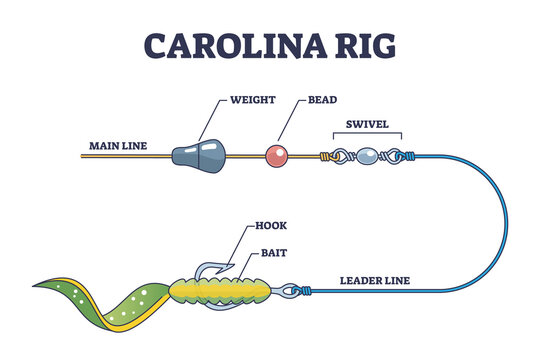
The Carolina rig is a very popular bass fishing rig for catching big largemouth bass. Let’s explore the components and the step-by-step setup process:
Components:
- Sliding Egg Sinker: The Carolina rig typically begins with a sliding egg sinker. The sinker is designed to slide freely on the fishing line, allowing the bait to move naturally while maintaining contact with the bottom.
- Swivel: A swivel is used to connect the mainline to the leader. It acts as a buffer, preventing line twist and allowing the bait to move independently from the sinker.
- Leader: The leader is a section of fishing line that connects the swivel to the hook. It is usually made of fluorocarbon or monofilament line and is typically longer than the mainline. The length of the leader can vary depending on fishing conditions and personal preference.
- Offset Hook: An offset hook is used in the Carolina rig setup. The hook is available in various sizes and styles, such as wide-gap or offset worm hooks. The offset design helps increase hook-up ratios and provides a weedless presentation.
- Soft Plastic Bait: The Carolina rig is often paired with a soft plastic bait, such as a creature bait, worm, or crawfish imitation. The soft plastic bait is threaded onto the hook, giving it a natural appearance and enticing action in the water.
Setup Process:
- Slide the Egg Sinker: Begin by sliding the egg sinker onto your mainline. The size of the sinker will depend on the depth you want to fish and the conditions you are facing.
- Tie the Swivel: Tie the swivel to the end of your mainline using a strong and reliable fishing knot, such as the Palomar knot. Ensure the knot is securely tied.
- Attach the Leader: Take your leader material and tie one end to the other side of the swivel using your preferred fishing knot. The leader length can vary depending on your fishing conditions, but a common range is 1 to 3 feet.
- Tie the Hook: Tie the offset hook to the other end of the leader using a strong fishing knot, such as the improved clinch knot. Ensure the knot is securely tied.
- Insert the Hook into the Bait: Take the offset hook and insert it into the head or nose of your soft plastic bait. Thread the hook through the body of the bait until the hook’s bend is concealed within the bait. This helps make the rig weedless and reduces snagging.
- Optional rigging variations: Depending on your preferences and fishing conditions, you can experiment with different rigging options, such as Texas-style rigging or Texposer-style rigging. These variations can influence the presentation and hooking potential of the bait.
How to Tie a Carolina Rig
Tips and Tricks for Beginners
- Choose the right sinker weight: The weight of the egg sinker used in the Carolina rig is crucial. Select a weight that allows you to maintain contact with the bottom while still providing a natural presentation. Adjust the weight based on the depth, current, and wind conditions to maximize your chances of attracting bass.
- Experiment with leader length: The length of the leader between the swivel and the hook can influence the presentation and the bass’s reaction. Try different leader lengths to see what works best for your fishing situation. Longer leaders can offer a more subtle presentation, while shorter leaders can provide better control and sensitivity.
- Optimize bait selection: The Carolina rig pairs well with various soft plastic baits, such as creature baits, worms, or crawfish imitations. Experiment with different bait colors, sizes, and styles to determine what the bass are most responsive to on a given day. Consider the water clarity and forage available in the area when making your bait selection.
- Focus on transition areas: Transition areas, where different types of bottom structure meet (e.g., rock to sand, vegetation to open water), can be productive spots for Carolina rig fishing. Bass often use these areas as travel routes or ambush points. Pay close attention to these transition zones and make accurate casts to maximize your chances of enticing bites.
- Be patient and thorough: When fishing the Carolina rig, cover the water thoroughly. Cast your rig at different angles and distances to explore different areas of the structure or cover you’re targeting. Take your time to work the rig slowly and methodically, allowing the bait to stay in the strike zone for longer periods.
- Stay aware of bottom composition: Pay attention to changes in bottom composition as you fish with the Carolina rig. Bass often relate to specific types of structure, such as rocks, gravel, or sand. Adjust your presentation and focus on areas with the most favorable bottom composition to increase your chances of finding active bass.
3. Drop Shot Rig
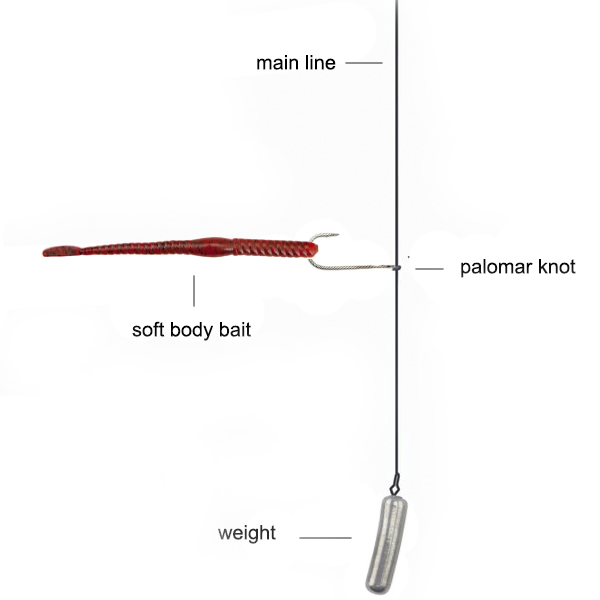
The drop shot rig is a very popular bas fishing rig. Here’s an explanation of the components and the step-by-step setup process:
Components:
- Drop Shot Weight: The drop shot rig utilizes a specialized weight called a drop shot weight or sinker. The weight is typically cylindrical or ball-shaped and has a hole or loop for the fishing line to pass through. The weight is attached below the hook and acts as an anchor to keep the bait suspended above the bottom.
- Hook: A drop shot rig employs a light wire, finesse-style hook. The hook size can vary depending on the size of the bait you’re using and the targeted fish species. The hook is tied to the line with a knot and positioned above the weight.
- Leader: A length of fluorocarbon or monofilament line is used as the leader in a drop shot rig. The leader is attached to the hook and provides the desired distance between the weight and the bait. The length of the leader can vary depending on personal preference and fishing conditions.
- Soft Plastic Bait: The drop shot rig is typically paired with a soft plastic bait, such as a finesse worm, minnow imitation, or creature bait. The bait is threaded onto the hook, allowing it to move naturally and create an enticing action underwater.
Setup Process:
- Tie the Hook: Begin by tying the drop shot hook to the end of your fishing line using your preferred fishing knot. The Palomar knot or the improved clinch knot are commonly used for this purpose. Ensure that the knot is securely tied.
- Attach the Drop Shot Weight: Pass the tag end of the line through the hole or loop of the drop shot weight. Slide the weight up the line until it reaches your desired distance from the hook. The weight can be positioned anywhere from a few inches to several feet below the hook, depending on the target depth.
- Attach the Leader: Tie the leader to the mainline above the drop shot weight using a knot such as the double uni knot or the Alberto knot. The length of the leader can vary depending on fishing conditions, but a common range is around 12 to 24 inches.
- Thread the Bait: Take your chosen soft plastic bait and thread it onto the hook. Depending on the bait’s shape, you can either nose hook it or thread it onto the hook horizontally or vertically. Ensure that the bait is securely attached and positioned straight on the hook.
- Test the Rig: Gently shake the rod or give the rig a few twitches to confirm that the weight is secure and the bait moves naturally. Adjust the leader length or weight position if necessary.
Tips and Tricks for Beginners
- Vary the leader length: Adjust the length of the leader between the hook and the weight based on the fish’s behavior and the structure you’re targeting. Longer leaders can create a more natural presentation and work well when bass are in a more finicky mood, while shorter leaders can provide better control and precision when fishing specific areas.
- Optimize bait selection: Soft plastic baits with subtle and finesse-like profiles work best for drop shot rig fishing. Experiment with different bait styles, colors, and sizes to match the forage in your fishing area and the preferences of the bass. Common choices include finesse worms, minnow imitations, and small creature baits.
- Try different rigging options: In addition to nose-hooking the bait, you can experiment with different rigging options to alter the presentation. Consider wacky rigging, where you hook the bait through the middle, or using a small drop shot hook with a weed guard when fishing around vegetation or cover.
- Pay attention to line tension: Since the drop shot rig is often fished with a slack line, pay close attention to any subtle changes in line tension. Be ready to detect bites or even slight taps, which can indicate bass taking the bait. Develop a sense for detecting these subtle strikes to improve your hook-up ratio.
- Use light tackle: Drop shot rig fishing is best done with light or ultralight spinning tackle. This allows for better sensitivity and finesse presentations. Match your rod, reel, and line weight to the size of the fish you’re targeting to optimize your experience and feel even the slightest nibbles.
4. Ned Rig
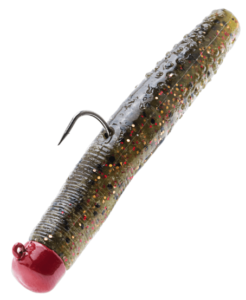
The Ned rig is a simple finesse setup that consists of a few key components. The Ned rig has become the favorite way to catch bass for many anglers, and here’s how it works:
Components:
- Jig Head: The Ned rig utilizes a small mushroom-shaped jig head as its main component. The jig head is typically lightweight and has a rounded head shape with a horizontal wire keeper or screw lock to secure the soft plastic bait.
- Soft Plastic Stick Bait: The Ned rig is typically paired with a soft plastic stick bait, such as a finesse worm or stick worm. These baits are usually shorter and feature a straight or slightly tapered profile. The soft plastic bait is threaded onto the jig head, allowing it to move naturally in the water.
Setup Process:
- Select the Jig Head: Choose a small mushroom-shaped jig head that matches the size of the soft plastic bait you plan to use. The weight of the jig head can vary depending on the depth and conditions you’re fishing in. Generally, lighter weights between 1/16 to 1/8 ounces are commonly used.
- Thread the Soft Plastic Bait: Take your selected soft plastic stick bait and insert the tip of the jig head’s hook into the head or nose of the bait. Continue threading the bait onto the jig head until it is securely positioned, ensuring that the bait is straight and centered on the jig head.
- Optional rigging variations: Depending on your preferences and fishing conditions, you can experiment with different rigging options for the Ned rig. For example, you can rig the bait Texposed, where the hook point is slightly exposed for increased hooking potential. Alternatively, you can rig it Texas style by burying the hook point into the bait, making it weedless.
- Test the Rig: Gently shake the rod or give the rig a few twitches to confirm that the bait is securely attached and the jig head is balanced. Adjust the bait if needed to ensure a natural and horizontal presentation.
Tips and Tricks for Beginners
- Use light tackle: Opt for a light or ultralight spinning rod and reel combo paired with a low-diameter braided or fluorocarbon line. Lighter gear allows for better sensitivity, accurate presentations, and a finesse approach that works well with the Ned rig.
- Experiment with color: Try different colors of soft plastic baits to determine what works best on a given day. Generally, natural and subtle colors like green pumpkin, watermelon, and natural shad tend to be effective, especially in clear or lightly stained waters. However, don’t be afraid to experiment with brighter or contrasting colors in murkier or stained conditions.
- Work different depths: The Ned rig is versatile and can be effective at various depths. Start by fishing closer to the bottom and gradually work your way up the water column to determine where the bass are feeding. Pay attention to any depth changes or structure that might attract bass.
- Slow and subtle retrieve: The key to the Ned rig’s effectiveness lies in its slow and subtle presentation. Use a slow drag or hop-and-pause retrieve, keeping the bait in close contact with the bottom. Allow the bait to sit momentarily between subtle movements, imitating a natural, easy meal for the bass.
- Pay attention to bottom contact: Maintain consistent contact with the bottom throughout your retrieve. The Ned rig’s lightweight jig head allows for easy detection of changes in bottom composition. If you feel a sudden tap or the bait stops moving smoothly, it could be an indication of a bass bite. Be ready to set the hook when you notice any unusual line movement.
- Experiment with retrieves: While a slow and subtle retrieve is the standard approach, don’t be afraid to vary your presentation. Try a few faster twitches or hops followed by longer pauses to trigger reaction strikes from more aggressive bass. Mix up your retrieve speed and style until you find what works best on a particular day.
5. Wacky Rig
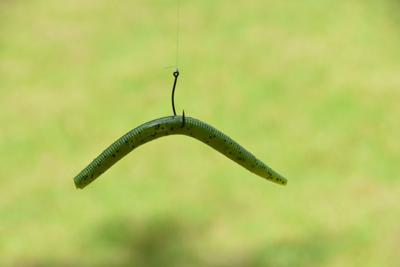
The wacky rig is a simple and popular finesse technique that requires minimal components, and is my personal favorite bass fishing rig. Here’s an explanation of the components and a step-by-step guide to help you set up and fish with the wacky rig:
Components:
- Wacky Hook: The wacky rig utilizes a specialized wacky hook, which is a short-shank hook with a wide gap. The hook is specifically designed for this rigging method, with a central point on the shank where the soft plastic bait is attached.
- Soft Plastic Bait: The wacky rig is typically paired with a soft plastic stick bait or worm. The bait should have a straight or slightly tapered profile and a texture that allows for subtle movement in the water. Common choices include stick worms, finesse worms, or Senko-style baits.
Setup Process:
- Select the Wacky Hook: Choose a wacky hook that matches the size of the soft plastic bait you plan to use. The hook size will depend on the targeted fish species and the bait’s dimensions. Opt for a hook with a wide gap to improve hooking potential.
- Determine the Hooking Point: With the soft plastic bait in hand, locate the center or midpoint of the bait’s body. This is where the hook will be inserted.
- Insert the Hook: Take the wacky hook and insert it perpendicularly into the midpoint of the bait’s body. The hook point should come out on the other side of the bait. The bait is effectively sandwiched between the hook and the line, creating a wobbling action.
- Rigging Options: Once the hook is inserted, you have a few rigging options to consider:
- O-Ring Method: Slide a small O-ring onto the bait, positioning it where the hook will be inserted. Insert the hook through the O-ring, securing the bait. This method helps prolong the bait’s lifespan as it reduces tearing.
- No O-Ring Method: If you prefer not to use an O-ring, you can rig the bait without one. Simply insert the hook directly into the bait, making sure it is securely positioned.
- Optional Weight: Depending on the bass fishing conditions, you can add a small nail weight or a wacky rig jig head near the head of the bait to increase its sink rate or to fish it deeper.
Tips and Tricks for Beginners
- Select the right soft plastic bait: Choose soft plastic baits with a straight or slightly tapered profile, as they work best for wacky rig fishing. Experiment with different colors, sizes, and textures to match the forage in your bass fishing area and the preferences of the bass. Common choices include stick worms, finesse worms, or Senko-style baits.
- Use light and sensitive tackle: Employ a light or ultralight spinning rod and reel combo, paired with a low-diameter braided or fluorocarbon line. This setup allows for better sensitivity, accurate casts, and subtle presentations that work well with the finesse nature of the wacky rig.
- Vary your casting and retrieval techniques: Experiment with different casting angles, distances, and retrieval speeds to cover a wide area and determine what triggers the most bites. Try casting near cover, submerged vegetation, or other potential bass-holding areas, and vary your retrieve between slow and steady, twitching, or shaking the rod tip to entice strikes.
- Pay attention to water temperature and conditions: The wacky rig can be effective throughout the year, but it shines in certain situations. During the pre-spawn and spawn periods, when bass are near their spawning areas, the wacky rig can be particularly productive. It also excels in clear or lightly stained waters and when bass are in a more finicky or less aggressive mood.
Conclusion
In conclusion, mastering best bass fishing rigs for beginners and pros opens up a world of possibilities.
From the Texas rig to the Carolina rig, drop shot rig, Ned rig, and wacky rig, each of the popular bass fishing rigs has its own purpose and advantages, but they all catch fish.
Whether you choose to use these bass fishing rigs or stick to more traditional bass fishing lures, make sure you have fun.
Don’t waste time. Once you have the bass fishing basics down, get out there, practice, and enjoy the thrill of bass fishing with these versatile rigs.
Happy fishing and tight lines!

